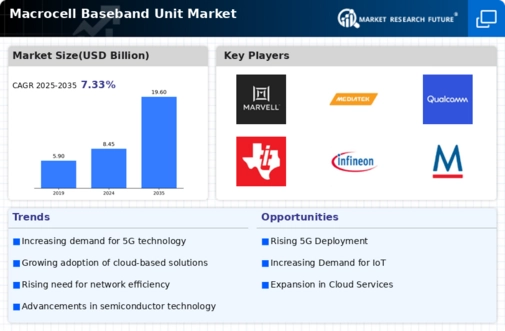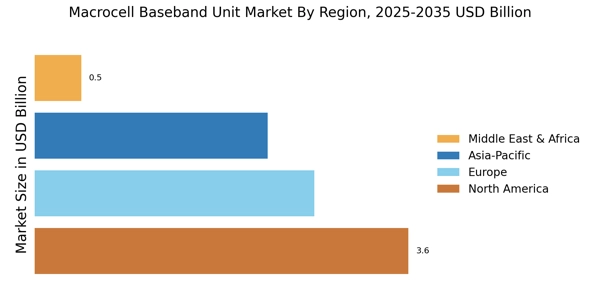The Macrocell Baseband Unit Market is currently characterized by a dynamic competitive landscape, driven by rapid technological advancements and increasing demand for high-speed mobile connectivity. Key players such as Huawei (China), Ericsson (Sweden), and Nokia (Finland) are at the forefront, each adopting distinct strategies to enhance their market positioning. Huawei (China) continues to focus on innovation, particularly in 5G technology, while Ericsson (Sweden) emphasizes strategic partnerships to bolster its service offerings. Nokia (Finland), on the other hand, is concentrating on regional expansion, particularly in emerging markets, thereby diversifying its operational footprint. Collectively, these strategies contribute to a competitive environment that is both collaborative and competitive, as companies seek to leverage their strengths to capture market share.
In terms of business tactics, localization of manufacturing and supply chain optimization are becoming increasingly critical. Companies are investing in local production facilities to mitigate risks associated with global supply chain disruptions. The Macrocell Baseband Unit Market appears to be moderately fragmented, with several key players exerting significant influence. This structure allows for a variety of competitive strategies, as companies navigate the complexities of regional regulations and customer preferences.
In August 2025, Ericsson (Sweden) announced a strategic partnership with a leading telecommunications provider in Southeast Asia to enhance 5G network deployment. This collaboration is expected to accelerate the rollout of advanced mobile services in the region, positioning Ericsson as a key player in the rapidly growing Southeast Asian market. The partnership underscores Ericsson's commitment to expanding its global footprint and enhancing its technological capabilities in 5G.
In September 2025, Nokia (Finland) launched a new suite of AI-driven solutions aimed at optimizing network performance and reducing operational costs for mobile operators. This initiative reflects Nokia's focus on integrating artificial intelligence into its product offerings, thereby enhancing its competitive edge. The introduction of these solutions is likely to attract new customers seeking to improve their network efficiency and service quality.
In July 2025, Huawei (China) unveiled its latest macrocell baseband unit, which incorporates advanced energy-saving technologies. This development not only aligns with global sustainability trends but also positions Huawei as a leader in environmentally friendly telecommunications solutions. The emphasis on energy efficiency is becoming increasingly relevant as operators seek to reduce their carbon footprints while maintaining high service standards.
As of October 2025, the competitive trends in the Macrocell Baseband Unit Market are heavily influenced by digitalization, sustainability, and the integration of artificial intelligence. Strategic alliances are playing a pivotal role in shaping the current landscape, as companies collaborate to enhance their technological capabilities and market reach. Looking ahead, it is anticipated that competitive differentiation will increasingly pivot from price-based strategies to innovation, technology advancements, and supply chain reliability, as companies strive to meet the evolving demands of the telecommunications sector.


















Leave a Comment